The James Bond Bedside Companion (54 page)
Read The James Bond Bedside Companion Online
Authors: Raymond Benson

Sean
Connery, the actor who became famous playing James Bond. (Photo by Arthur Evans, Wide World Photo.)
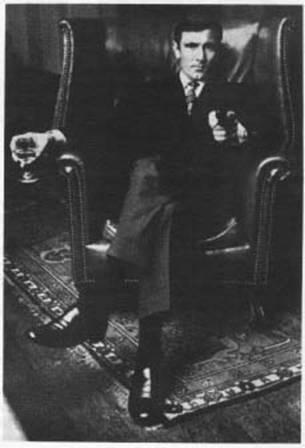
George Lazenby portrayed James Bond one time in the
1969-released
On Her Majesty's Secret Service.
(Photo by
Terry
O'Neil, Globe
Photos.)
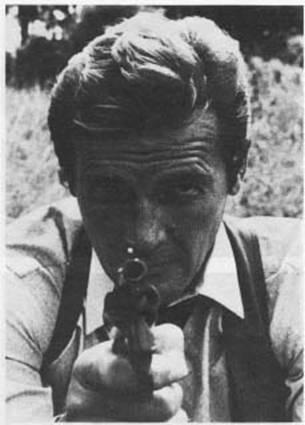
The new 007. Roger Moore takes over the role in the 1973-released
Live and Let Die
. (Wide World Photo.)
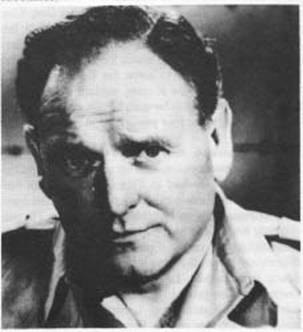
The late Bernard Lee appeared as a character actor in more than 100 films. He was best known for portraying Bond's Chief, M. (UPI Photo.)
Moore was born in 1927 and had his first break as an extra in
Caesar and Cleopatra
(1945). He understudied David Tomlinson in the London stage production of
The Little Hut
, which brought him a certain amount of recognition. This brought interest from Hollywood, where he made films such as The Last Time I Saw Paris (1954),
Interrupted Melody
and
The King's Thief
(both 1955), and starred opposite Lana Turner in
Diane
(also 1955). Moore became very successful in the British TV series
Ivanhoe
, and went on to international fame as TV's Simon Templar in
The Saint
and in a recurring role in
Maverick
.
Since
Live and Let Die
was released in 1973, Moore has been accepted as and has remained James Bond in the Eon Productions series.
The most puzzling feature common to all three actors cast as 007 over the years is their uniform lack of suitability for the role. None of them really resembles Bond as Fleming intended him. When the author first saw Sean Connery, he was reportedly aghast and claimed that the actor was "totally wrong." But after seeing Connery in character, Fleming changed his mind, and even gave the literary James Bond a Scottish heritage in subsequent novels. But the cinematic James Bond remains quite different from the man in the books. Connery could have played Bond as Fleming had written him had the screenplays allowed. But the film scripts put the accent on humor; and Bond in the movies was dapper, witty, and extremely nonchalant Connery did play a tougher Bond than Moore, and his dry delivery of gag lines somehow fit the sardonic detachment with which the literary Bond regarded life. Moore, on the other hand, is quite bland in the role. The directors and scenarists of the later pictures require the actor to embody a James Bond who stands idly by with a twinkle in his eye while frantic action explodes harmlessly around him. Moore's Bond is simply too nice and well mannered to be a James Bond of any real substance.
Three other British actors have been important to the series: the late Bernard Lee, who portrayed M in eleven of the films; Lois Maxwell, who still plays Miss Moneypenny; and Desmond Llewelyn, who has brought to life the role of
Q,
the Armourer.
Lee was born in 1908 and played character roles in many films, including The
Fallen Idol
(1948),
The Third Man
(1949),
Father Brown
(1954), and
Whistle Down the Wind
(1961); but he was best known to audiences around the world as Bond's crusty boss. Lee passed away after
Moonraker
was released, and his role was replaced by the characters of the Minister of Defense and Chief of Staff Bill Tanner in
For Your Eyes Only.
Veteran actor Robert Brown took over the role in
Octopussy.
Lee perfectly embodied the M of the novels in his aloofness toward Bond, although he tended to become comically perturbed at Bond's addiction to a wild life (women, fast cars, etc.). But Lee exhibited M's paternalism and wisdom quite well. He will be missed.
Lois Maxwell was born Lois Hooker in Canada in 1927. After a brief Hollywood career, she settled in England, where she made several films, including
Corridor
of
Mirrors
(1948, directed by Terence Young),
The Woman's Angle
(1952),
Kill Me Tomorrow
(1957), and Stanley Kubrick's
Lolita
(1962). She is probably best known as Miss Moneypenny, M's faithful secretary with a lifelong crush on James Bond. The short flirtatious scenes between Moneypenny and Bond in the films range from pleasant and refreshing to trite and maudlin. But Maxwell exhibits the requisite charm for Moneypenny, and does quite well in the role. (It's interesting to note that the character was given quite a bit more to do in the films than in the novels.) Maxwell, incidentally, is the only other person besides producer Broccoli to have been associated with each Bond film.
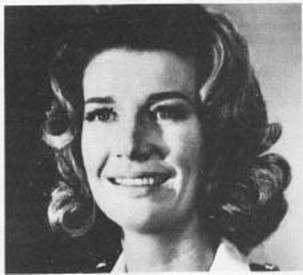
Lois Maxwell, as the ever-faithful Miss Moneypenny. (Wide World Photo.)
Q
(in the novels and first couple of films he is called Major Boothroyd) is the head of the weapons branch and is always turning up in the films with some new gimmick for Bond to use. In the first film,
Dr. No
(in which Boothroyd was portrayed by Peter Burton), all he presents to Bond is a new pistol. Desmond Llewelyn took the role in
From Russia With Love
and issues Bond an attaché case with all kinds of clever devices. In
Goldfinger,
Bond acquires the famous Aston Martin equipped with a veritable arsenal. From then on, each successive film features a more impressive type of weapon than the last Llewelyn's
Q
shares the cine
matic M's disgust at the way Bond treats his equipment,
women, etc. As the films progress, Q becomes more and more sarcastic, and the Q/Bond scenes function as comic relief. Llewelyn, having made a career as a character actor in a number of British films, is fine in the role.
Other actors will be discussed in relation to the particular films in which they appear.
OTHER ASPECTS
A
ll the Bond films, particularly those with larger budgets, are impressive visually. They all feature lavish photography, beautiful sets, and believable special effects. Sound is an important part of all the films—usually recorded at an exaggerated volume. Fight scenes are accompanied by a resounding "CRRRRAAASSHHH" when a fist meets a jaw, and gunshots and explosions are deafening. Cinematography is usually very
beautiful—Thunderball
features some impressive underwater photography never before attempted, and
You Only Live Twice
provides panoramic views of Japan. But the artistic ingredients that figure most prominently in the Broccoli/Saltzman formula are the production designs and musical scores.
The man responsible for the unmistakable look of a Bond film is Ken Adam, a German-born designer who has worked on a number of distinguished films,
including Queen
of
Spades (
1948),
Around the World in Eighty Days
(1956), Dr.
Strangelove
(1964),
Sleuth
(1972), and many others. He won an Academy Award
for art direction for Stanley Kubrick's
Barry Lyndon
(1975). Inspired by classic German cinema design, Adam
brought an expressionistic look to his settings—surreal angles, sloping ceilings, and sharp changes of line direction. He designed all but five of the pictures, and must be considered a major contributor to the Bond film formula.
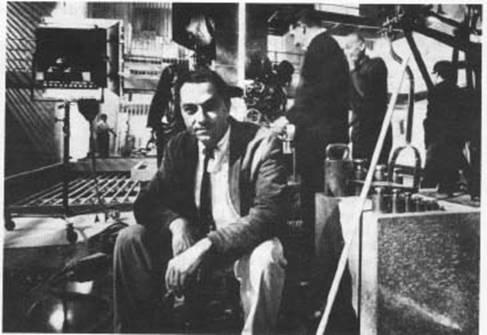
Designer Ken Adam in front of his fabulous Fort Knox set for
Goldfinger
. (Photo by Loomis Dean, Life Magazine. © Copyright 1964 by Time, Inc.)
Syd Cain, the art director who took over for Ken Adam on
From Russia With Love
,
On Her Majesty's Secret Service
, and
Live and Let Die
, took a more realistic approach to his designs.
From Russia With Love
featured no fantastic designs except for SPECTRE's training camp.
Live and Let Die
, however, did tend to copy Adam's expressionistic designs a little, especially in Dr. Kananga's laboratory at the film's end.
Peter Mutton designed
The Man With the Golden Gun
, which recalls Ken Adam's work; but this film was enhanced by the special effects and model work of Derek Meddings, who has been special effects supervisor for each Bond film since 1974. Meddings' work is good, and he is well known in the field, along with Douglas Trumbull, John Stears, and John Dykstra. Meddings was nominated for an Academy Award for his work on
Moonraker
. (He won the Oscar in 1978 for
Superman
.) Another man in the special effects field who has been with the Bond films since the beginning is John Stears, who won an Academy Award for visual effects for
Thunderball
. His work is outstanding in each film. Peter Lamont, an art director from previous Bond films, made an impressive debut as production de signer on
For Your Eyes Only
, and his work will be discussed in that section.
